Many questions and answers at crowded seminar on urban waterways
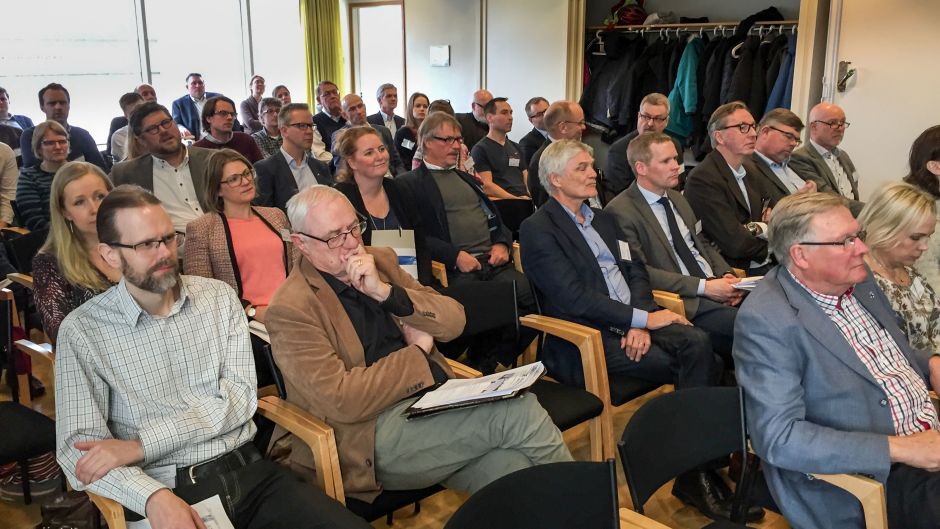
How can urban waterway reach environmental goals and be an option for both passengers and freight transports? And is the society interested in urban waterways? These were some of the topics when Lighthouse and the Maritime Cluster of West Sweden held a seminar on urban waterways and shipping.
Every seat was taken and it was about 70 people, from scientists to politicians, who attended the seminar "Water in the city - barrier or growth?". The purpose of the seminar was to discuss the opportunities, driving forces, barriers and opportunities for urban shipping. Jim Sandkvist who is senior advisor at SSPA believe that there are many signs of the urban shipping potential. Daily transport of water could reduce pressure on land-based traffic, and in a city that is expanding, urban shipping can play a major role in everything from transporting people to the delivery of construction materials and waste.
-If urban shipping with passenger traffic and extensive daily distribution of goods would have been economically viable, then it would already be available. But it’s not. Therefore, we must analyse and focus on other aspects of urban shipping, such as environmental benefits, public economy and public welfare, Jim Sandkvist says.
Environmental impact of shipping is a concern
Leif Magnusson is a strategist at Region Västra Götaland who runs the region's public transport company Västtrafik. According to him, shipping is just one (1) percent of Västtrafiks passenger transports. At the same time shipping constitute for six percent of Västtrafiks energy consumption, 15 percent of carbon dioxide emissions (CO2), 23 percent of nitrogen oxides (NOx) and 54 percent of particle pollution (PM). Part of the explanation for the numbers is due to Västtrafik extensive use of electric traffic by land.

But shipping’s high energy consumption and high environmental impact is a concern for the Region of Västra Götaland and the goal that at least 95 percent of public transport should be made with renewable energy in 2025. There is ongoing work in the region to look at ways to improve vessel traffic. For example, through a feasibility study on the use of biogas and / or electricity in ferry traffic, if it is possible to increase the amount of electric power on Älvskyttlarna that traffics the river of Götra Älv in Gothenburg or if the Marstrand ferry could run on electricity. Even HVO, renewable diesel, in diesel engines is investigated.
- If you can you create shortcuts in the city with help of waterways and reduce the cost of infrastructure and land transport, then I think there is an opening to link the city with help of urban shipping, Leif Magnusson says.
One problem with new technology and innovation is that companies like Västtrafik, whose first responsibility is to ensure that the technology works and the reliability is high, have it hard to try out new technology.
- We have learned, not least on the bus side, that development and innovation is difficult to do in a procurement situation. We need to find other ways to show and demonstrate new technologies that go beyond normal procurement channels, Leif Magnusson says.

Karl Garme, researcher at the Royal Institute of Technology believes that the figures from Region Västra Götaland about the environmental impact are based on old shipping technology and that there’s a need for modern and lighter vessels. If modern waterborne traffic would be fully integrated with the infrastructure system, there would be several advantages to urban shipping in a city. The waterways can relieve the infrastructure by land, increase transport capacity, increase the reliability of the infrastructure system, reduce environmental impact and help bike commuting and bicycle business.
- In city and public transport planning there is a risk that we don’t consider waterborne traffic, Karl Garme says.
Wants to take ferry passengers directly to the final destination
According to Anders Werner, shipping manager for Färjerederiet who operates Swedens road ferries, there’s an increasing demand for waterborne public transport. But the road network by land is not able to meet up with the demands from the road ferries.
- We have four ferries that go all day between Öckerö and Lilla Varholmen. Our passengers want more departures but there is no place to drop off the cars, the roads are full and those who live close to the ferry terminal are irritated because of congested roads, Anders Werner says.
His hope is not primarily to deposit more car ferries between Öckerö and Lilla Varholmen but to run the passengers straight to their final destination. For example, directly into town.

- Everyone wants a thriving archipelago but how can we have a thriving archipelago if we can’t get there, Anders Werner says.
Anders Werner also tells us that Färjerederiet is trying to reduce its energy consumption and environmental impact. For example, through electrification, both by using batteries and by running electricity through cable from shore. But there’s also environmental benefits to be gained by trying to change how the captain handles the vessel. According to Färjerederiets own studies there’s up to 50 percent difference in fuel consumption between different captains and Färjerederiet have built a special simulator in Vaxholm to train their crews in ecoship driving.
Dreaming of urban passenger ferry on methanol
Emissions and environmental impacts is a challenge for all modes of transport and a challenge to become fossil-free is to not let the energy consumption grow despite increasing growth, says Bengt Ramne who is a Professor of the Practice at Chalmers University of Technology / Scandinaos.According to him, shipping is the most energy efficient transportation option if utilized properly. For example, in large volumes and weights, if the waterway is a shortcut, high transport speed is unimportant, or that efficient intermodal solutions exist.Shipping is also the best environmental option if the right fuel is used. It is important to find out when, where and how the various energy carriers are used and Bengt Ramne highlights methanol as an alternative.

-A dream project is to rebuild a passenger ferry (Älvsnabben) to methanol operation. Methanol can be produced in large volumes as a fossil-free fuel, you avoid sulphur emissions and particles and what is left catalysts can take care of, Bengt Ramne says.
As for the electrification of shipping there are many advantages for limited distances, a good example is the electrical cable-driven ferry in Hamburgsund. But there are also some special challenges for shipping when it comes to electric operation. Shipping has a need of major energy stocks, fewer opportunities to recharge and the extra weight from the batteries provide a greater resistance in the sea than on land.
But the biggest problem right now, according to Bengt Ramne, is that low oil prices keep the commercial sector’s interest for alternative fuels to a minimum.
Watch and learn from a shopping centre
Regardless of the potential at sea it becomes increasingly crowded on land. More and more people gather around the cities and the competition for street space increases. The research project DenCity is looking into solutions and services that can reduce congestion, reduce environmental impact and increase the quality of life for those who reside in dense urban areas.

And urban shipping can play an important role in that matter says Martin Svanberg from SSPA and one of the project participants in DenCity.Urban shipping could provide environmental benefits in terms of reduced carbon emissions and noise pollution. Also congestion, into and within the city, could be reduced. A tangible proposal DenCity is investigating is to transport goods from small terminals along the river Göta Älv to the port Frihamnen in Gothenburg.
–We must dare to be innovative in the future, we need many different types of solutions, it is not just a boat, one size fits all, Martin Svanberg says.
DenCity also make comparisons of different ships and look into different terminals.–What kind of cargo, carriers and boats should be handled? I think you can learn a lot from how a shopping centre operates, for example can you build a loading dock for urban shipping in the first floor of a house close to the water, Martin Svanberg says.
Priority on electrification in Norway
You don’t need to go far to find good examples of how you can work with urban shipping. Norway has a green coastal shipping program that says that Norway should have the world's most efficient and environmentally friendly coastal shipping.
-In Norway they have succeeded to get a broad support for the coastal shipping program. There’s a mutual platform and focus on pilot projects, Mikael Johansson from DNV GL, one of the seminar's speakers, says.Shipping is seen in Norway as an extremely important and profiled industry says Mikael Johansson. They talk about it as the country’s third largest export industry. They are also concerned that shipping has a significant environmental impact and there is a great challenge to meet future needs for increased transport while emissions must be reduced.-To get a mutual platform to stand on, Norway found out how shipping contributes to emissions and how different branches of shipping is contributing. Which emissions come from domestic shipping, from import and export shipping and how much pollution comes from pure transit?, Mikael Johansson says.
The conclusion was that, if a third of the coastal shipping fleet in Norway would be more environmentally friendly, emissions would be cut by 40 percent. For example, by alternative fuels.

- The green coastal shipping program in Norway focuses on electrification. Electrification is a reality today and that’s where they put their effort. They have been working with gas, with methanol and other biofuels, to find solutions for the electrification and completely remove CO2 emissions, Mikael Johansson says.
Norway now has 22 hybrid vessels and one ferry that runs solely on batteries in operation. And in the future, most vessels will be hybrids or plug-in hybrid solutions that are combined with other environmentally friendly fuels such as gas. Norway's goal in the green coastal shipping program is to have the world's most efficient and environmentally-coaster run wholly or partly by batteries, LNG or other environmentally-friendly fuel. The work involves a large number of actors from the highest political level to maritime subcontractors.-To get the entire industry involved is something they worked very hard with, Mikael Johansson says.
Gothenburg slow in approaching the water
The seminar "Water in the city - barrier or growth?" took place in Gothenburg. A city that despite its proximity to the water has not taken advantage of the water's potential, according to the city architect of Gothenburg, Björn Siesjö.

–We have built the wrong city for a number of years. We have created a vision of a river city where one of the targets was to approach the water, but we have been slow compared to other cities, Björn Siesjö says.
Compared to other cities of similar size, Gothenburg is one of the most sparsely populated cities in Europe, and the city needs to be densified. It is necessary, according to Björn Siesjö, to build 100 000 new apartments and one area of development is Frihamnen, close to the water in central Gothenburg.
–We are working intensively with the area and to get close to the water. People want to get close to the water, see the water, being on the water.
But water as part of an extensive public transport system is nothing Gothenburg would benefit from at the moment, Björn Siesjö thinks.
- If we are going to work every day, rain or shine, we want it to be convenient and fast. Then people might prefer to take the bus to the other side of the river instead of the ferry. But during the summer months I would like to have more passenger transports on the water, for both tourist and people in the city, Björn Siesjö says.
- Gothenburg is a city that was founded and developed because of it’s waterways. The water is a premise of Gothenburg and I think it's a pity that it does not continue, the ships get bigger and bigger and is moved toward the mouth of the river and the shipping on the Göta Älv river slowly becomes less and less, he continues.
The panel discussionThe main question for the concluding panel discussion was the challenges that the urban shipping faces. Ulf Eriksson, who is a politician and deputy chairman of the Regional Development Office in the Region of Västra Götaland says that the political decisions they take must have a sustainable perspective.
- This includes both environmental and social sustainability. But also economical sustainability. And you have to be able to make long term decisions. Many calculations are not necessarily profitable in the short term, such as converting the transport system to become fossil fuel independent, but in the long term there will probably be a different result. The political objective is to support the development which allows one to reach the long term goal, Ulf Eriksson says.

Ellinor Svensson, shipping and quality manager at Styrsöbolaget calls for advance planning and better collaboration between policy makers.
- Take the new stone pier in central Gothenburg as an example. There they have built a nice stone pier which we will operate into. There are politicians who want us to run the boats there, but it is not established with Västtrafik who has their way of thinking and their budgets. So decisions are made in two different places without the parties collaborating. It costs a lot of money and is difficult for us as private entrepreneurs to relate to, Ellinor Svensson says.
Leif Magnusson, strategist at the Region of Västra Götaland means that it is not a given that shipping will replace land transport when new climate targets has to be achieved. Shipping must show that they can offer an effective way to reach the climate targets. As a good example of how you can work with development, Leif Magnusson mentions the electric bus project ElectriCity in Gothenburg.
- It is a demonstration and development project that is in addition to the usual public transportation system. It's pretty low risks of such a project as it supplements the network we already have. I think this can be a good way to go, but it costs a lot of money to start that kind of project, and that’s something the politicians must prioritize. Where should the funds be invested?, Leif Magnusson says.
A lot about to happen
Technological development and demonstration projects are costly but Niklas Arvidsson, who is a researcher at the School of Business, Economics and Law at Gothenburg University believes that there will be good opportunities to find various sustainable transport solutions from an urban perspective in the future. The reason is the European Commission White Paper on transport.
- White papers are strategically important in order to conduct research and bring community development forward, and the White Paper on transport basically says that in year of 2030, all city centres in Europe's major cities should have zero emissions for freight transports. There, certain types of vehicles and vessels on the water can be a part of the solution. It will happen a lot in the next five to ten years, says Niklas Arvidsson.

Text and photos: Andreas Kron
-
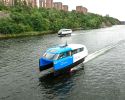 Ny studie: Eldrivna pendelbåtar kan effektivisera Stockholms kollektivtrafik
Ny studie: Eldrivna pendelbåtar kan effektivisera Stockholms kollektivtrafik -
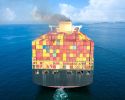 Sjöfartens utsläpp ökar
Sjöfartens utsläpp ökar -
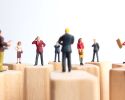 Sociala relationer påverkar val av bränsle
Sociala relationer påverkar val av bränsle -
 Sjöfartens omställning kräver ”mjukare” påtryckningar
Sjöfartens omställning kräver ”mjukare” påtryckningar -
 Hon hade avtalad tid med Kapten ynkrygg
Hon hade avtalad tid med Kapten ynkrygg -
 Lighthouse omvärldsanalys 2025 – osäkerhet och tullar präglar sjöfarten
Lighthouse omvärldsanalys 2025 – osäkerhet och tullar präglar sjöfarten -
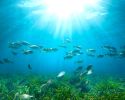 Se seminariet Shipping in the Marine Environment
Se seminariet Shipping in the Marine Environment -
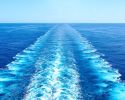 Vad betyder egentligen de 90 procenten?
Vad betyder egentligen de 90 procenten? -
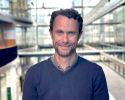 Hålla där...
Hålla där... -
 Ny rapport: Klimatförändringarna ett hot mot de flesta större hamnar i världen
Ny rapport: Klimatförändringarna ett hot mot de flesta större hamnar i världen

